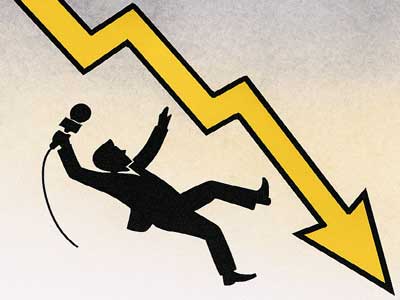Once upon a time, the newspaper editor was a formidable institution. A single line from his desk could rattle the very foundations of power. Today, many readers can't even recall the name of their preferred paper’s editor. The values that elevated journalism and gave it its luminous purpose are now fading rapidly, eclipsed by the shadow of market pressures. News, once a badge of integrity, is now just another commodity, its worth measured by sales, ratings, and clicks.
Editorial pages have shrunk, their gravitas eroded. The keen edge of the cartoonist’s pen has yielded to the digital mouse of the graphic designer, while artificial intelligence threatens to deepen the upheaval. Soon, even the hallowed library corner, the heartbeat of the newsroom, echoing with the rustle of facts and archives, may vanish. This isn’t just the advent of new technology; it marks the corrosion of journalism’s soul.
Read in Hindi: गिरावट की ओर पत्रकारिता और बिकता हुआ सच
The shift didn’t happen long ago. It was the 1970s, when we emerged from the portals of IIMC, filled with the idealism of fledgling journalists. Back then, editors were national icons as BG Verghese, Sham Lal, Mulgaokar, Kuldip Nayar, Russi Karanjia, Khushwant Singh, Rajendra Mathur, N Ram, Sarveshwar, Shrikant, Ageya, Ratanlal Joshi, Dharamvir Bharati, to name a few; their names have become legend. Cartoonists, too, were torchbearers, Laxman, Ranga, Cho, Sudhir Dar, Kak, Vijayan and many others. Journalism was revered as a sacred calling; the newsroom, a temple dedicated to the pursuit of truth and the unyielding scrutiny of power.
Advertising and public relations professionals were viewed with scepticism, their access to the newsroom strictly policed. A definitive boundary separated news from commerce, respected by all.
That boundary has been erased. Today, journalists often seek the favour of politicians and the powerful, where once discretion and subtlety preserved the profession’s dignity. What was hidden is now brazenly displayed—journalists have morphed into influencers, deal-makers, brokers, and lobbyists.
Reporters who once spoke truth to power now push products, promote leaders, and help spread rumours. Consultants and ‘fixers’ have taken up permanent residence in media houses, their influence no longer covert. The game is out in the open, and its risks are profound.
The worth of independent, fearless journalism has plummeted. News stories are no longer simple presentations of fact; they are flung at audiences, infused with opinion and sensationalism, all to chase higher ratings or more lucrative clicks. Lavish pay packets, glamorous lifestyles, and the lure of easy money have normalised compromise. Allegations of blackmail are now frequent and troubling.
Gift-giving at press conferences to curry coverage has become routine. Cash envelopes and gift vouchers are handed out openly. News stories often read more like sponsored packages than reporting.
Digital media has accelerated this decline. TV channels, newspapers, and news portals have all but obliterated the distinction between advertising and journalism. Sponsored content masquerades as news. Brands dictate what stories appear, while inconvenient ones vanish.
The Niira Radia tapes exposed how top journalists functioned as intermediaries between corporates and the corridors of power. The term ‘Godi Media’, lapdog media, stands as damning evidence of this collusion.
This malaise is far from confined to India. In America, the 2020 election season saw Instagram and TikTok influencers being openly paid for political promotion. Hollywood’s ‘native ads’, Bollywood’s ‘press junkets’, across the globe, the line between journalism and marketing is now desperately faint.
The culprit, ultimately, is commercial pressure. Newsrooms shrink, budgets dwindle, and journalists fight for survival in the gig economy. Corporate owners and political patrons push their preferred agendas with ease. Once a watchdog for democracy, journalism has become the mouthpiece of power and capital.
Some say that lobbying is now an unavoidable part of journalism, a necessity for survival. But accepting this is to sign journalism’s death certificate. When truth is up for sale and journalists become mere fixers, democracy begins to totter.
The crisis is urgent, but not irreversible. If readers and viewers demand a clear firewall between news and advertisements, if sponsored content is transparently labelled, and media organisations pivot to subscription models, some dignity might be restored. Most crucial is media literacy. The public must learn to discern news from opinion, reporting from propaganda.
The decline of journalism is not just a professional emergency; it is a democratic one. If the media chooses only to display the polished face of those in power, leaving society’s true visage out of the frame, democracy’s mirror grows dim.
Restoring the honour and purity of journalism is vital. This is not nostalgia for old times, but the nation’s insurance for the future.


















Related Items
Will caste and religious walls collapse in Bihar this time…?
India stuck in traffic; Cities halt, Horns holler, and time takes a nap
Time has come to embrace the eternal Hindu identity…